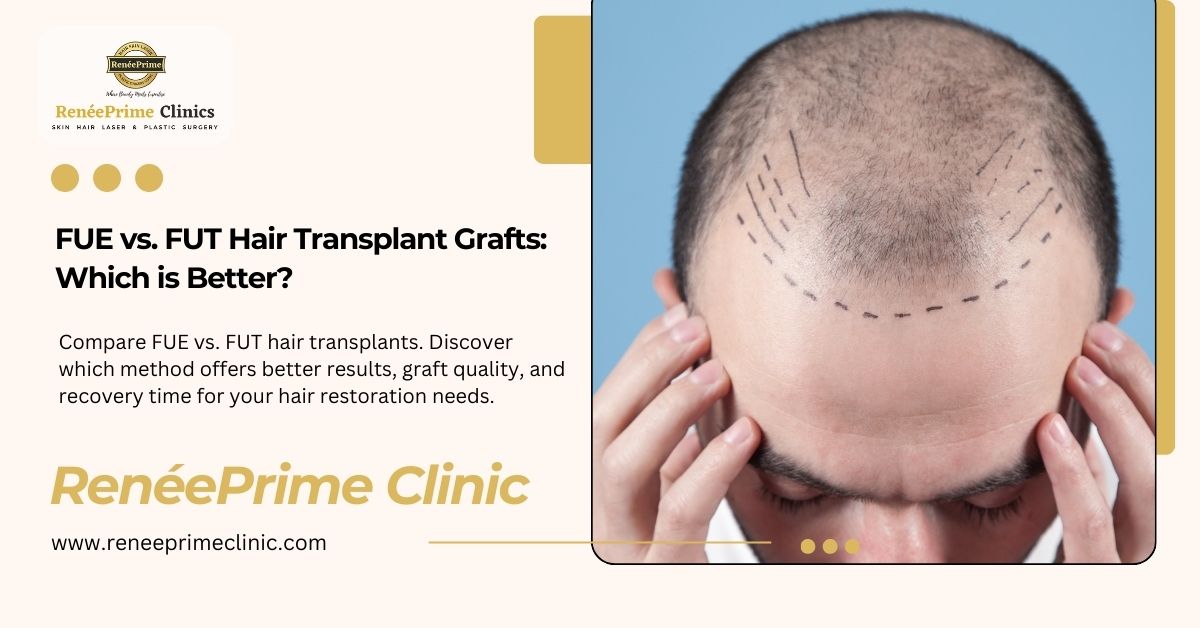Many people who experience hair loss look for different approaches to restore their hair. Medical science offers hair transplant surgery as a popular and effective solution for restoring hair among patients. Two prominent hair graft transplant methods exist which are FUE (Follicular Unit Extraction) and FUT (Follicular Unit Transplantation).
The methods have different approaches for extracting hair follicles which leads to distinct surgical procedures and healing periods. The following article explores the differences between FUE and FUT hair transplant grafts while examining their benefits and drawbacks and recommending suitable procedures based on individual circumstances.
What is FUE (Follicular Unit Extraction)?
Individual hair follicles get extracted through FUE directly from the scalp before getting transplanted into bald or thinning areas. The surgeon extracts follicles from the back and sides of the scalp because hair in these locations tends to resist typical patterns of hair loss.
The surgical tool used for follicle extraction operates as a circular punch instrument with a diameter between 0.8 to 1 millimeters. The physician arranges the extracted follicles with great care before placing them into the designated recipient location for natural growth.
Advantages of FUE:
1. Minimal Scarring: The FUE technique provides minimal scarring because it extracts individual follicles through small incisions thus producing better results than FUT. The tiny surgical hole from FUE extraction becomes almost undetectable because it results in minimal scarring that will not create visible marks on the skin.
2. Faster Recovery: FUE patients recover their new hair faster than FUT patients do. The procedure produces fewer postoperative discomfort symptoms because the absence of a large incision causes less tissue trauma.
3. No Need for Stitches: The procedure of FUE avoids stitches because it remains less invasive than FUT.
4. Natural Results: The exact placement of individual follicles based on calculations results in a natural hairline along with better-grained coverage.
5. No Linear Scar: The FUE procedure creates no linear scar on the scalp which makes it appealing to people with short hairstyles.
Disadvantages of FUE:
1. Longer Procedure Time: FUE requires a longer operating duration because it extracts individual follicles separately which extends the procedure duration when many grafts are needed.
2. Higher Cost: FUE procedures cost more than other methods because the precise nature of the procedure demands additional expenses.
3. Possible Follicle Damage: The extraction process for FUE carries a small yet possible risk of harming follicles that could impact hair growth.
What is FUT (Follicular Unit Transplantation)?
FUT hair transplant operates under the name “strip method” and requires medical professionals to extract skin strips from donor locations located on the back or sides of the scalp. The surgeon divides the skin strip into microscopic follicular units before placing these units into thinning and bald areas of the scalp.
Medical practitioners have used the FUT technique for hair transplant since the 1970s. The FUT procedure allows for permanent hair restoration despite being slightly less minimally invasive than FUE.
Advantages of FUT:
1. Higher Graft Yield: The FUT hair transplant procedure enables doctors to collect a higher quantity of grafts from one surgical session which benefits patients with extensive hair loss.
2. Faster for Larger Areas: FUT works faster on extensive bald regions because removing a small skin strip provides enough material to extract multiple grafts simultaneously.
3. Cost-Effective: FUT offers price advantages over FUE since it costs less which makes it appealing to patients who need economical hair restoration solutions.
4. More Grafts in One Session: A single FUT procedure allows practitioners to collect and transplant more grafts since the strip of skin provides a larger harvest volume.
5. Potential for Better Density: The higher number of grafts from FUT leads to denser hair transplantation results particularly when doctors move large quantities of hair.
Disadvantages of FUT:
1. Linear Scar: The main disadvantage of FUT hair treatment involves the linear scar which persists at the skin removal site. The scar remains visible when hair length is shortened to a short style.
2. Longer Recovery Time: FUT demands longer healing times together with stitching requirements because of the extensive surgical cut. FUT produces more discomfort along with an extended recovery period.
3. More Invasive: The surgical nature of FUT results in higher invasiveness than FUE because it requires scalp cutting followed by stitching.
4. Risk of Complications: The surgical procedure creates possible complications because any operation carries risks which may include infection together with numbness and difficulties stemming from the incision site.
FUE vs. FUT Hair Transplant Grafts: Which is Better?
The right procedure between FUE and FUT depends on your individual requirements as well as the extent of your hair loss and your financial resources. Several important elements should guide your decision between FUE vs. FUT Hair Transplant Grafts procedures.
1. Amount of Hair Loss: The FUT procedure stands as the optimal choice for individuals who need multiple grafts because it provides an efficient harvesting method. One session using this technique enables the extraction of a higher number of grafts. For smaller thinning hair sections FUE can be sufficient but it creates minimal scarring.
2. Desired Aesthetic and Scarring: FUE could be your best choice if you want to avoid linear scarring because you plan to keep your hair short since this method does not create visible scarring. People with longer hair typically do not notice the scar that follows FUT because it hides underneath their natural hair length.
3. Budget Considerations: FUE costs more than FUT because it demands high precision and takes longer for the medical procedure. FUT proves more affordable than FUE for patients who base their selection on cost.
4. Recovery Time: Patients seeking quicker recovery times should choose FUE since it delivers superior results in this area. The procedure results in less tissue damage and requires fewer stitches and produces less swelling in patients. Patients who need to work right after their hair transplant procedure should choose FUE because it provides a shorter recovery period.
5. Long-Term Results: The permanent results of FUE and FUT will remain if you have sufficient healthy donor hair follicles. The outcome of FUE and FUT procedures relies greatly on surgeon expertise as well as pre- and post-operative care quality delivered by the medical staff.
Conclusion
Hair transplant treatments performed by FUT and FUE methods provide enduring and effective solutions to hair loss but face different advantages and complications in their approach. People who want a minimally invasive procedure that produces minimal scarring and quick recovery times should choose FUE whereas FUT gives better results for those needing larger grafts at a more cost-effective price.
Your optimal choice depends on your individual objectives and your specific hair loss condition together with your preferences regarding healing time and visibility of scars. The identification of your suitable hair transplant procedure should start with consulting a specialist who possesses hair transplant expertise.
Frequently Asked Questions
Which Method is Better for Those With a Tight Scalp?
FUE proves advantageous for people with a tight scalp since it avoids removing extensive skin sections. The FUE small punch tools adapt well to patients who need restricted flexibility in their donor area.
Can FUE and FUT Be Combined?
Many patients choose to combine FUE with FUT for their hair restoration procedures when they require extensive graft coverage. The combination technique provides the best features of FUE alongside FUT to deliver outstanding coverage alongside personalized cosmetic outcomes.
Will I Experience Hair Loss Again After a Transplant?
The transplanted hair follicles become permanent but natural hair loss through genetic factors might affect non-transplanted areas. Long-term care treatments serve to keep the whole appearance maintained.
How much does FUE vs. FUT cost?
The cost of FUE spans between 4,000 and 15,000 based on graft requirements yet FUT typically costs between 3,000 and 10,000. The cost of hair transplant surgery depends on three main factors which include the medical facility where the procedure takes place and the location of the facility and the professional experience of the surgeon.
If you’re considering a Hair transplant in Mumbai, it’s essential to research the clinic’s reputation and success rates.





